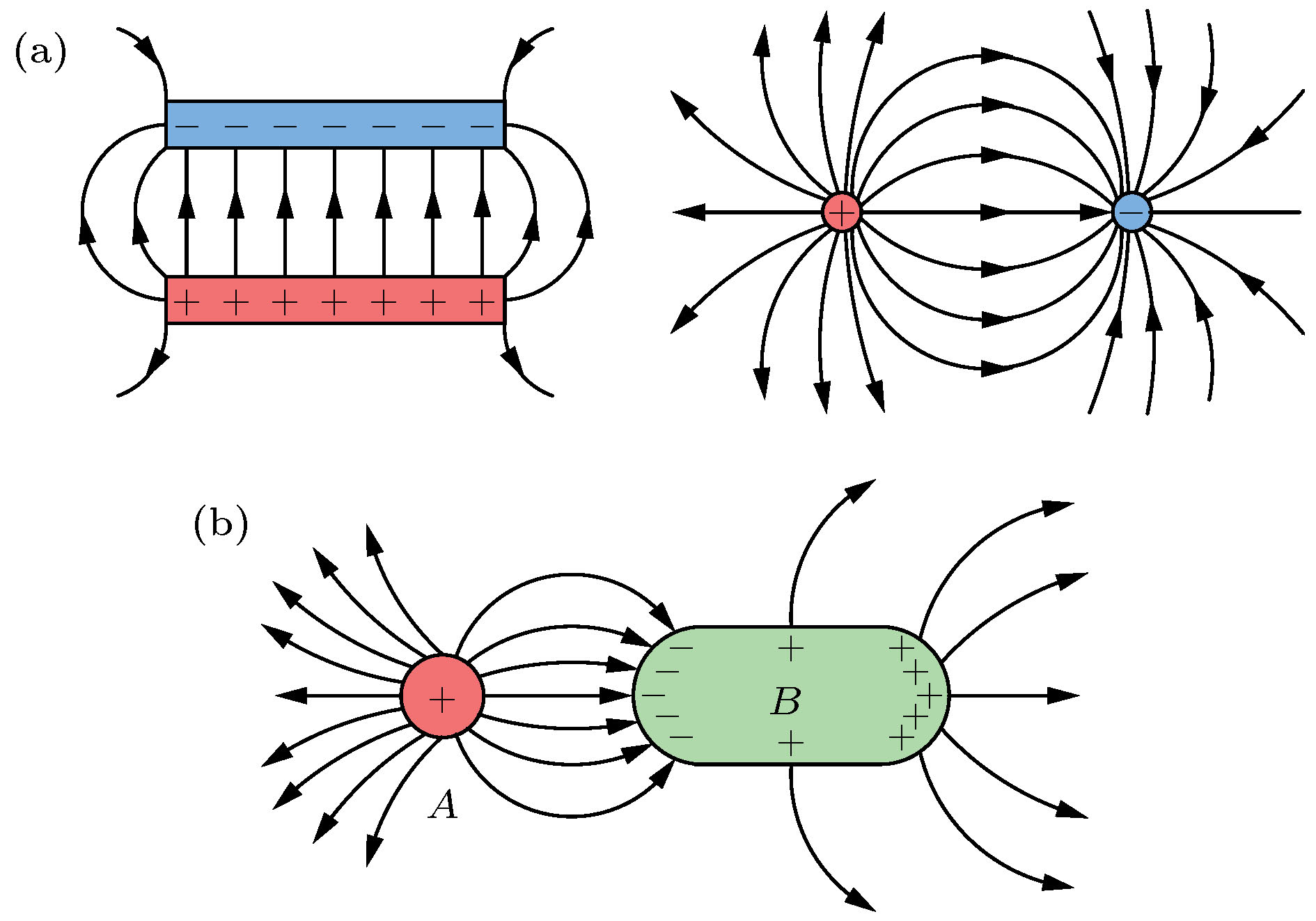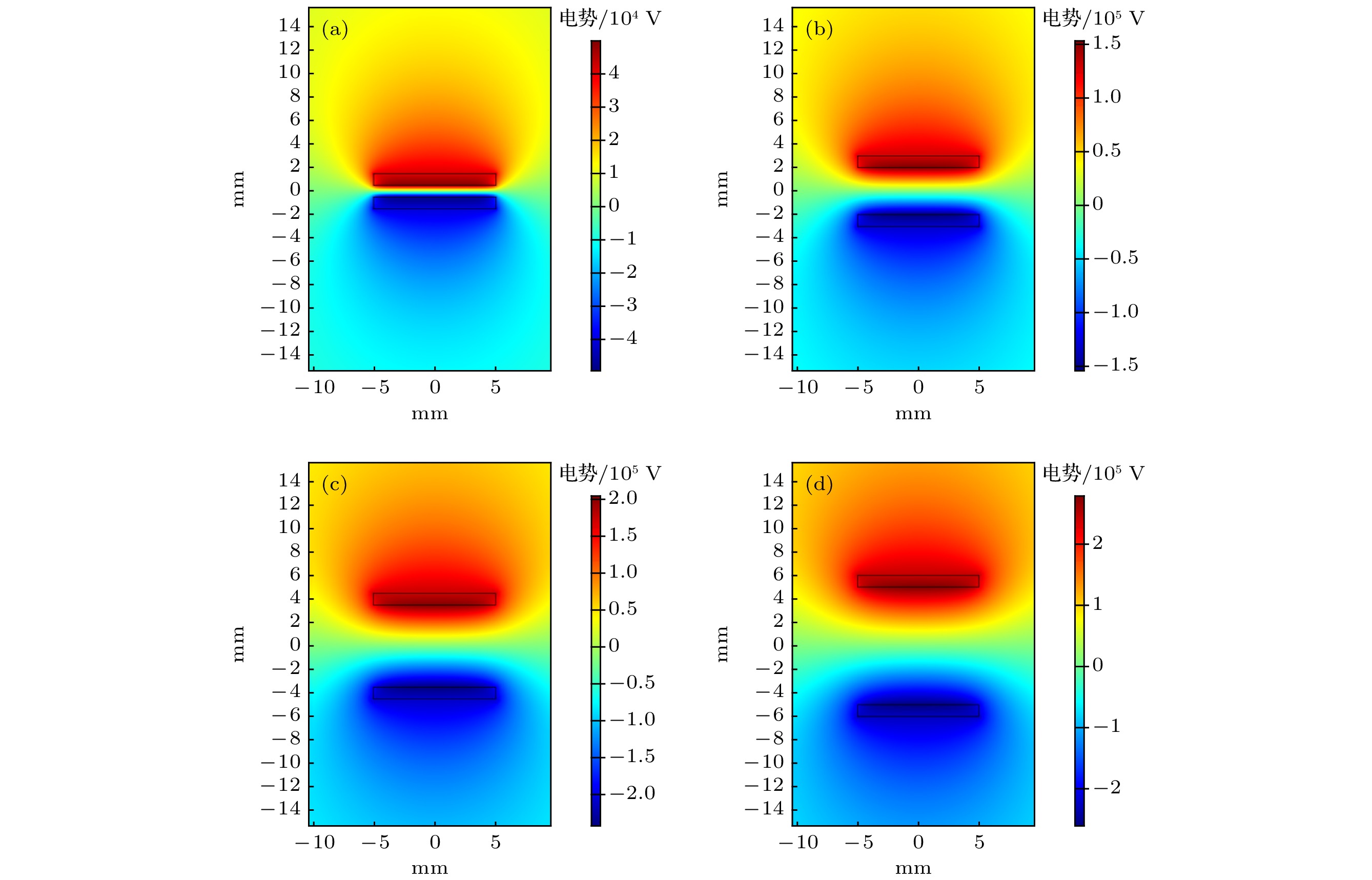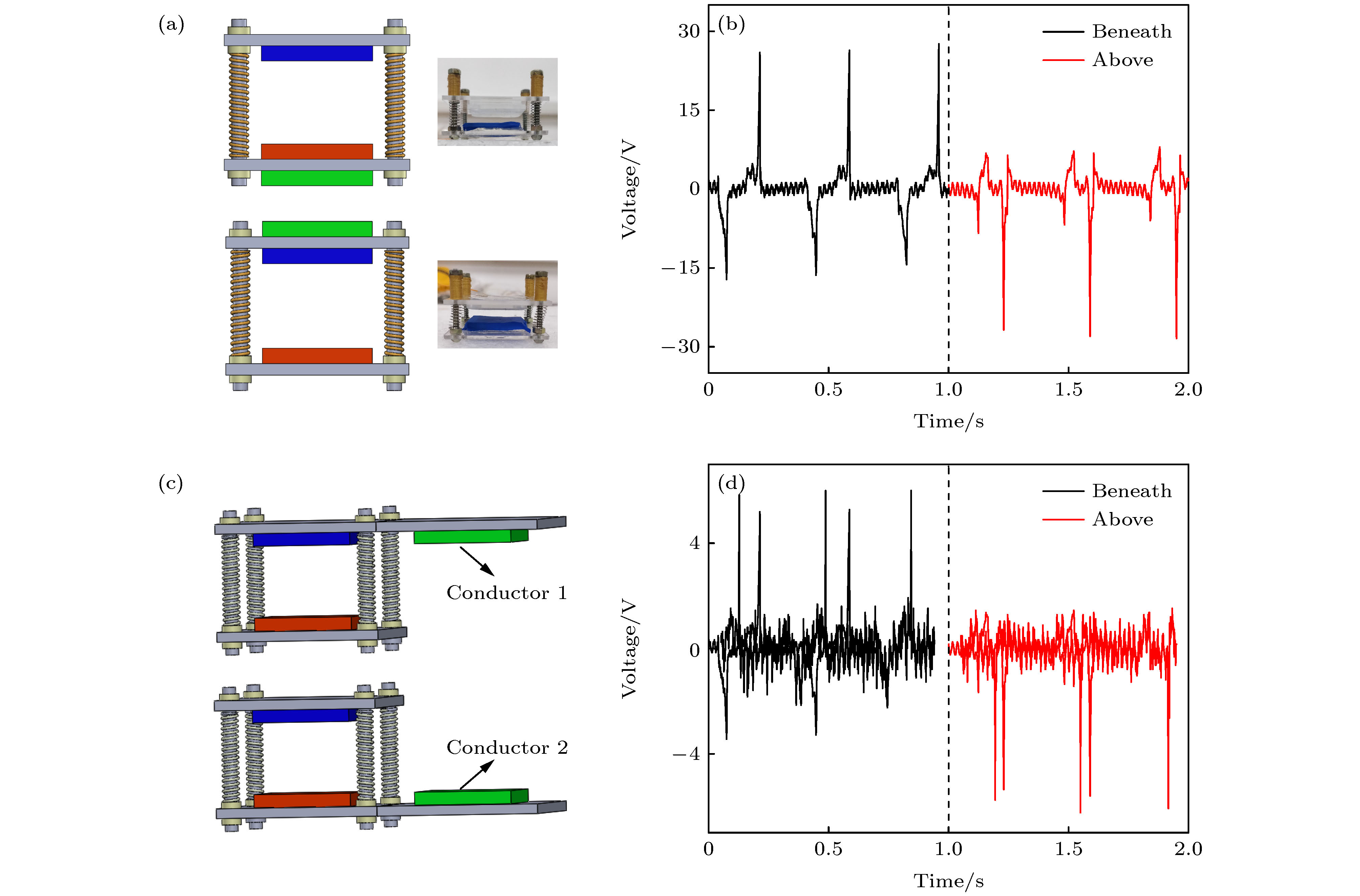-
Triboelectric nanogenerator (TENG) and its self-powered sensor based on the principles of contact electricity generation and electrostatic induction have important application prospects in the fields of new energy and internet of things (IoT). In the contact separation process of polymer materials with different electronegativity values, due to the transfer of electrons, a changing electrostatic field will be generated in the space around the polymer. In the existing TENG research, the field strength perpendicular to the plane of the friction layer and the electrode layer is mainly used to generate electrostatic induction, and the electric field effect around the polymer is ignored. According to the principle of electrostatic induction, the internal charge of the conductor in the electric field will be redistributed, which provides a way for the conductor to generate an induced electrical signal on the surface of the conductor without contacting the friction material. In this paper, we design a non-contact triboelectric nanogenerator (NC-TENG) based on changing electrostatic field. The influence of the distance between the conductor and the friction material, the induction area of the conductor and the position of the conductor relative to the friction material on the induced electrical output performance are studied when silicone rubber and nitrile rubber are used as a friction material. The results show that the NC-TENG can produce a stable electrical signal output when the conductor is completely separated from the friction material. The induced voltage of NC-TENG decreases with the increase of the distance between the conductor and the friction material, and gradually increases with the increase of the conductor's induction area. For the friction material with a size of 30 mm × 30 mm, the electrical output of NC-TENG tends to be stable when its conductor area is 60 mm × 45 mm. In addition, the different orientation of the conductor relative to the friction material also has a significant effect on the induced electrical output. The NC-TENG designed in this paper provides a novel electrical output generation mode, which provides a higher possibility for the subsequent research on TENG and the application of self-powered sensors.
-
Keywords:
- changing electric field /
- non-contact /
- triboelectric nanogenerator /
- electrostatic induction
[1] Yin E, Li Q, Xuan Y 2019 Appl. Energy 236 560
 Google Scholar
Google Scholar
[2] Bu L, Chen Z, Chen Z, Qin L, Yang F, Xu K, Han J, Wang X 2020 Nano Energy 70 104500
 Google Scholar
Google Scholar
[3] Xing F, Jie Y, Cao X, Li T, Wang N 2017 Nano Energy 42 138
 Google Scholar
Google Scholar
[4] Zhong W, Xu L, Wang H, Li D, Wang Z 2019 Nano Energy 66 104108
 Google Scholar
Google Scholar
[5] Liu X, Cheng K, Cui P, Qi H, Qin H, Gu G, Shang W, Wang S, Cheng G, Du Z 2019 Nano Energy 66 104188
 Google Scholar
Google Scholar
[6] Cheng G, Lin Z, Du Z, Wang Z 2014 ACS Nano 8 1932
 Google Scholar
Google Scholar
[7] Fan F, Tian Z, Wang Z 2012 Nano Energy 1 328
 Google Scholar
Google Scholar
[8] Chung J, Lee S, Yong H, Moon H, Choi D, Lee S 2016 Nano Energy 20 84
 Google Scholar
Google Scholar
[9] Yang W, Wang X, Li H, Wu J, Hu Y 2018 Nano Energy 51 241
 Google Scholar
Google Scholar
[10] Seol M, Han J, Moon D, Yoon K, Hwang C, Meyyappan M 2018 Nano Energy 44 82
 Google Scholar
Google Scholar
[11] Jing Q, Zhu G, Bai P, Xie Y, Chen J, Han R, Wang Z 2014 ACS Nano 8 3836
 Google Scholar
Google Scholar
[12] Gogurla N, Roy B, Park J, Kim S 2019 Nano Energy 62 674
 Google Scholar
Google Scholar
[13] Paosangthong W, Wagih M, Torah R, Beeby S 2019 Nano Energy 66 104148
 Google Scholar
Google Scholar
[14] Xi F, Pang Y, Liu G, Wang S, Li W, Zhang C, Wang Z 2019 Nano Energy 61 1
 Google Scholar
Google Scholar
[15] Zhang Z, He J, Wen T, Zhai C, Han J, Mu J, Jia W, Zhang B, Zhang W, Chou X, Xue C 2017 Nano Energy 33 88
 Google Scholar
Google Scholar
[16] Kim W, Bhatia D, Jeong S, Choi D 2019 Nano Energy 56 307
 Google Scholar
Google Scholar
[17] 吴晔盛, 刘启, 曹杰, 李凯, 程广贵, 张忠强, 丁建宁, 蒋诗宇 2019 物理学报 68 190201
 Google Scholar
Google Scholar
Wu Y S, Liu Q, Cao J, Li K, Cheng G G, Zhang Z Q, Ding J N, Jiang S Y 2019 Acta Phys. Sin. 68 190201
 Google Scholar
Google Scholar
[18] Liu X, Zhao K, Yang Y 2018 Nano Energy 53 622
 Google Scholar
Google Scholar
[19] Kim D, Tcho I, Choi Y 2018 Nano Energy 52 256
 Google Scholar
Google Scholar
[20] Lee J, Kim S, Kim T, Khan U, Kim S 2019 Nano Energy 58 579
 Google Scholar
Google Scholar
[21] Yang X, Chan S, Wang L, Daoud W 2018 Nano Energy 44 388
 Google Scholar
Google Scholar
[22] Cui P, Wang J, Xiong J, Li S, Zhang W, Liu X, Gu G, Guo J, Zhang B, Cheng G, Du Z 2020 Nano Energy 71 104646
 Google Scholar
Google Scholar
[23] Zhang R, Hummelgård M, Örtegren J, Olsen M, Andersson H, Olin H 2019 Nano Energy 57 279
 Google Scholar
Google Scholar
[24] Xia K, Zhu Z, Zhang H, Du C, Fu J, Xu Z 2019 Nano Energy 56 400
 Google Scholar
Google Scholar
[25] Lin H, Liu Y, Chen S, Xu Q, Wang S, Hu T, Pan P, Wang Y, Zhang Y, Li N, Li Y, Ma Y, Xie Y, Wang L 2019 Nano Energy 65 103944
 Google Scholar
Google Scholar
[26] Lim G, Kwak S, Kwon N, Kim T, Kim H, Kim S, Kim S, Lim B 2017 Nano Energy 42 300
 Google Scholar
Google Scholar
[27] Feng Y, Huang X, Liu S, Guo W, Li Y, Wu H 2019 Nano Energy 62 197
 Google Scholar
Google Scholar
[28] Meng X, Cheng Q, Jiang X, Fang Z, Chen X, Li S, Li C, Sun C, Wang W, Wang Z 2018 Nano Energy 51 721
 Google Scholar
Google Scholar
[29] Wu C, Ding W, Liu R, Wang J, Wang A, Wang J, Li S, Zi Y, Wang Z 2018 Mater. Today 21 216
 Google Scholar
Google Scholar
[30] Chen J, Pu X, Guo H, Tang Q, Feng L, Wang X, Hu C 2018 Nano Energy 43 253
 Google Scholar
Google Scholar
[31] Zhang W, Wang P, Sun K, Wang C, Diao D 2019 Nano Energy 56 277
 Google Scholar
Google Scholar
[32] Heo D, Kim T, Yong H, Yoo K, Lee S 2018 Nano Energy 50 1
 Google Scholar
Google Scholar
[33] Zhao K, Gu G, Zhang Y, Zhang B, Yang F, Zhao L, Zheng M, Cheng G, Du Z 2018 Nano Energy 53 898
 Google Scholar
Google Scholar
[34] Liu D, Yin X, Guo H, Zhou L, Li X, Zhang C, Wang J, Wang Z 2019 Sci. Adv. 005 6437
 Google Scholar
Google Scholar
[35] Li S, Liu D, Zhao Z, Zhou L, Yin X, Li X, Gao Y, Zhang C, Zhang Q, Wang J, Wang Z 2020 ACS Nano 14 2475
 Google Scholar
Google Scholar
[36] Jiang T, Chen X Y, Yang K D, Han C B, Tang W, Wang Z L 2016 Nano Res. 009 1057
 Google Scholar
Google Scholar
[37] 程广贵, 张伟, 方俊, 蒋诗宇, 丁建宁, Pesika N S, 张忠强, 郭立强, 王莹 2016 物理学报 65 060201
 Google Scholar
Google Scholar
Cheng G G, Zhang W, Fang J, Jiang S Y, Ding J N, Pesika N S, Zhang Z Q, Guo L Q, Wang Y 2016 Acta Phys. Sin. 65 060201
 Google Scholar
Google Scholar
[38] 王中林, 林龙, 陈俊, 牛思淼, 訾云龙 2017 摩擦纳米发电机 (北京: 科学出版社) 第14−15页
Wang Z L, Lin L, Chen J, Niu S M, Zi Y L 2017 Triboelectric Nanogenerator (Beijing: Science Press) pp14−15 (in Chinese)
-
图 6 基于变化静电场的NC-TENG工作原理图 (i)初始状态, 丁腈橡胶与硅胶刚接触; (ii)丁腈橡胶与硅胶逐渐分离, 丁腈橡胶和硅胶表面所带静电荷产生静电场; (iii)丁腈橡胶和硅胶分离到最大距离, 此时丁腈橡胶和硅胶之间电势差达到最大; (iv)丁腈橡胶和硅胶分离距离逐渐减小, 彼此之间的电势差也在减小
Figure 6. Working principle diagram of NC-TENG based on changing electrostatic field: (i) Initial state, nitrile rubber and silicone rubber are just in contact; (ii) nitrile rubber and silicone rubber are gradually separated, the surface of nitrile rubber and silicone rubber is charged and generate an electrostatic field; (iii) the nitrile rubber and the silicone rubber are separated to the maximum distance, at this time the potential difference between the nitrile rubber and the silicone rubber reaches the maximum; (iv) the separation distance between the nitrile rubber and the silicone rubber gradually decreases and the potential difference between them is also decreasing.
图 7 基于变化静化场的NC-TENG结构图及输出测量图 (a) NC-TENG结构图; (b) 距摩擦材料不同距离时的输出性能; (c) 不同导体面积时的输出性能
Figure 7. Structure diagram of NC-TENG based on changing electrostatic field and electrical signal output measurement diagram: (a) Structure diagram of NC-TENG; (b) the output performance of the TENG under different distance from the friction material; (c) the output performance of the TENG under different conductor area.
图 8 基于变化静电场的NC-TENG电信号输出与导体所处方位关系图 (a)导体处于硅胶正上方和丁腈橡胶正下方以及(b)相应的电信号输出; (c)导体距离硅胶/丁腈橡胶15 mm且分别位于硅胶同一平面和丁腈橡胶同一平面以及(d)相应的电信号输出
Figure 8. Research on the relationship between the electrical signal output of the NC-TENG and the position of the conductor: (a) The conductor is directly above the silicone rubber and directly under the nitrile rubber and (b) the corresponding electrical signal output; (c) the conductor is 15 mm away from the silicone/nitrile rubber and is located on the same plane of silicone and nitrile rubber and (d) the corresponding electrical signal output.
-
[1] Yin E, Li Q, Xuan Y 2019 Appl. Energy 236 560
 Google Scholar
Google Scholar
[2] Bu L, Chen Z, Chen Z, Qin L, Yang F, Xu K, Han J, Wang X 2020 Nano Energy 70 104500
 Google Scholar
Google Scholar
[3] Xing F, Jie Y, Cao X, Li T, Wang N 2017 Nano Energy 42 138
 Google Scholar
Google Scholar
[4] Zhong W, Xu L, Wang H, Li D, Wang Z 2019 Nano Energy 66 104108
 Google Scholar
Google Scholar
[5] Liu X, Cheng K, Cui P, Qi H, Qin H, Gu G, Shang W, Wang S, Cheng G, Du Z 2019 Nano Energy 66 104188
 Google Scholar
Google Scholar
[6] Cheng G, Lin Z, Du Z, Wang Z 2014 ACS Nano 8 1932
 Google Scholar
Google Scholar
[7] Fan F, Tian Z, Wang Z 2012 Nano Energy 1 328
 Google Scholar
Google Scholar
[8] Chung J, Lee S, Yong H, Moon H, Choi D, Lee S 2016 Nano Energy 20 84
 Google Scholar
Google Scholar
[9] Yang W, Wang X, Li H, Wu J, Hu Y 2018 Nano Energy 51 241
 Google Scholar
Google Scholar
[10] Seol M, Han J, Moon D, Yoon K, Hwang C, Meyyappan M 2018 Nano Energy 44 82
 Google Scholar
Google Scholar
[11] Jing Q, Zhu G, Bai P, Xie Y, Chen J, Han R, Wang Z 2014 ACS Nano 8 3836
 Google Scholar
Google Scholar
[12] Gogurla N, Roy B, Park J, Kim S 2019 Nano Energy 62 674
 Google Scholar
Google Scholar
[13] Paosangthong W, Wagih M, Torah R, Beeby S 2019 Nano Energy 66 104148
 Google Scholar
Google Scholar
[14] Xi F, Pang Y, Liu G, Wang S, Li W, Zhang C, Wang Z 2019 Nano Energy 61 1
 Google Scholar
Google Scholar
[15] Zhang Z, He J, Wen T, Zhai C, Han J, Mu J, Jia W, Zhang B, Zhang W, Chou X, Xue C 2017 Nano Energy 33 88
 Google Scholar
Google Scholar
[16] Kim W, Bhatia D, Jeong S, Choi D 2019 Nano Energy 56 307
 Google Scholar
Google Scholar
[17] 吴晔盛, 刘启, 曹杰, 李凯, 程广贵, 张忠强, 丁建宁, 蒋诗宇 2019 物理学报 68 190201
 Google Scholar
Google Scholar
Wu Y S, Liu Q, Cao J, Li K, Cheng G G, Zhang Z Q, Ding J N, Jiang S Y 2019 Acta Phys. Sin. 68 190201
 Google Scholar
Google Scholar
[18] Liu X, Zhao K, Yang Y 2018 Nano Energy 53 622
 Google Scholar
Google Scholar
[19] Kim D, Tcho I, Choi Y 2018 Nano Energy 52 256
 Google Scholar
Google Scholar
[20] Lee J, Kim S, Kim T, Khan U, Kim S 2019 Nano Energy 58 579
 Google Scholar
Google Scholar
[21] Yang X, Chan S, Wang L, Daoud W 2018 Nano Energy 44 388
 Google Scholar
Google Scholar
[22] Cui P, Wang J, Xiong J, Li S, Zhang W, Liu X, Gu G, Guo J, Zhang B, Cheng G, Du Z 2020 Nano Energy 71 104646
 Google Scholar
Google Scholar
[23] Zhang R, Hummelgård M, Örtegren J, Olsen M, Andersson H, Olin H 2019 Nano Energy 57 279
 Google Scholar
Google Scholar
[24] Xia K, Zhu Z, Zhang H, Du C, Fu J, Xu Z 2019 Nano Energy 56 400
 Google Scholar
Google Scholar
[25] Lin H, Liu Y, Chen S, Xu Q, Wang S, Hu T, Pan P, Wang Y, Zhang Y, Li N, Li Y, Ma Y, Xie Y, Wang L 2019 Nano Energy 65 103944
 Google Scholar
Google Scholar
[26] Lim G, Kwak S, Kwon N, Kim T, Kim H, Kim S, Kim S, Lim B 2017 Nano Energy 42 300
 Google Scholar
Google Scholar
[27] Feng Y, Huang X, Liu S, Guo W, Li Y, Wu H 2019 Nano Energy 62 197
 Google Scholar
Google Scholar
[28] Meng X, Cheng Q, Jiang X, Fang Z, Chen X, Li S, Li C, Sun C, Wang W, Wang Z 2018 Nano Energy 51 721
 Google Scholar
Google Scholar
[29] Wu C, Ding W, Liu R, Wang J, Wang A, Wang J, Li S, Zi Y, Wang Z 2018 Mater. Today 21 216
 Google Scholar
Google Scholar
[30] Chen J, Pu X, Guo H, Tang Q, Feng L, Wang X, Hu C 2018 Nano Energy 43 253
 Google Scholar
Google Scholar
[31] Zhang W, Wang P, Sun K, Wang C, Diao D 2019 Nano Energy 56 277
 Google Scholar
Google Scholar
[32] Heo D, Kim T, Yong H, Yoo K, Lee S 2018 Nano Energy 50 1
 Google Scholar
Google Scholar
[33] Zhao K, Gu G, Zhang Y, Zhang B, Yang F, Zhao L, Zheng M, Cheng G, Du Z 2018 Nano Energy 53 898
 Google Scholar
Google Scholar
[34] Liu D, Yin X, Guo H, Zhou L, Li X, Zhang C, Wang J, Wang Z 2019 Sci. Adv. 005 6437
 Google Scholar
Google Scholar
[35] Li S, Liu D, Zhao Z, Zhou L, Yin X, Li X, Gao Y, Zhang C, Zhang Q, Wang J, Wang Z 2020 ACS Nano 14 2475
 Google Scholar
Google Scholar
[36] Jiang T, Chen X Y, Yang K D, Han C B, Tang W, Wang Z L 2016 Nano Res. 009 1057
 Google Scholar
Google Scholar
[37] 程广贵, 张伟, 方俊, 蒋诗宇, 丁建宁, Pesika N S, 张忠强, 郭立强, 王莹 2016 物理学报 65 060201
 Google Scholar
Google Scholar
Cheng G G, Zhang W, Fang J, Jiang S Y, Ding J N, Pesika N S, Zhang Z Q, Guo L Q, Wang Y 2016 Acta Phys. Sin. 65 060201
 Google Scholar
Google Scholar
[38] 王中林, 林龙, 陈俊, 牛思淼, 訾云龙 2017 摩擦纳米发电机 (北京: 科学出版社) 第14−15页
Wang Z L, Lin L, Chen J, Niu S M, Zi Y L 2017 Triboelectric Nanogenerator (Beijing: Science Press) pp14−15 (in Chinese)
Catalog
Metrics
- Abstract views: 16873
- PDF Downloads: 273
- Cited By: 0















 DownLoad:
DownLoad:







